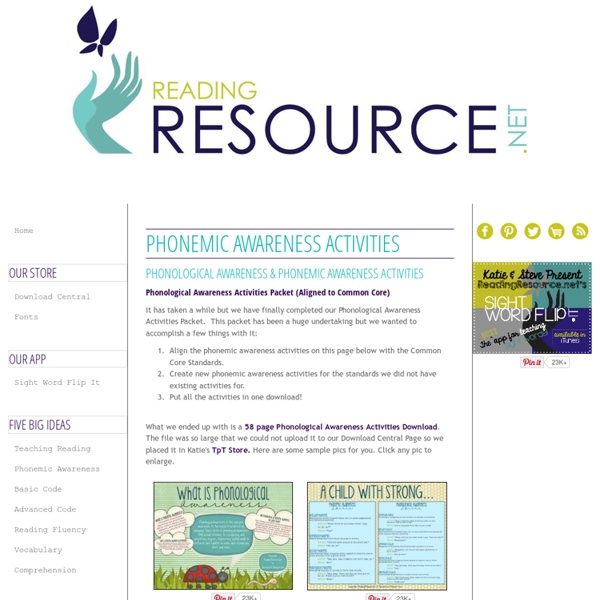5 Quick, Easy, and Fun Phonemic Awareness Activities
Learning to read can be quite an overwhelming task for small children. In fact, if you think about it, it’s astounding that children are even capable of learning to read in such a short amount of time. However, before they begin to read print, they must have an adequate foundational understanding of how sounds in words work. What is phonemic awareness? In easy-to-understand terms, phonemic awareness is the ability to identify, think about, and manipulate sounds in spoken speech. Listening The ability to listen closely is a key ingredient of phonemic awareness. The Listening Game. One of the first phonemic-awareness activities I do with my students, even as soon as the first day, is to bring their attention to noises. “Moo-Moo,” Where Are You? I love playing this game with my class. Rhyming Rhyming is such a great phonemic awareness activity! In My Box This game is great to use after your students have at least some understanding of how rhyming works. Syllables Bippity Boppity Bumble Bee
Phonological Awareness: Instructional and Assessment Guidelines
By: David J. Chard and Shirley V. Dickson This article defines phonological awareness and discusses historic and contemporary research findings regarding its relation to early reading. Common misconceptions about phonological awareness are addressed. Research-based guidelines for teaching phonological awareness and phonemic awareness to all children are described. Row, row, row your boat gently down the stream. Activities like substituting different sounds for the first sound of a familiar song can help children develop phonological awareness, a cognitive substrate to reading acquisition. No area of reading research has gained as much attention over the past two decades as phonological awareness. What is phonological awareness, and why is it important to beginning reading success? What is phonological awareness? Phonological awareness is the understanding of different ways that oral language can be divided into smaller components and manipulated. Teaching phonological awareness Figure 2.
Phonemic Awareness Assessment Tools
Recognizing Rhyme Assessment Here are two different versions of the Rhyming Assessment tool: Recognizing Rhyme Assessment NO QuickTime movie version Recognizing Rhyme Assessment QuickTime version: Watch Patti do a demonstration of the rhyme assessment.) Isolating Beginning Sounds Isolating Final Sounds Phoneme Blending Assessment Phoneme Blending Assessment (No QuickTime required) Phoneme Blending Assessment (QuickTime movie version: Watch Patti demonstrate the assessment.) Yopp-Singer Test of Phonemic Segmentation (No QuickTime required)
Words that rhyme with cat
Phonemic Awareness is the ability to hear and manipulate sounds in words. Phonemic Awareness includes skills such as blending sounds, segmenting sounds, rhyme, on-set/rhyme and beginning and ending sound awareness.
How Now Brown Cow: Phoneme Awareness Activities
Research indicates a strong relationship between early phoneme awareness and later reading success, and it links some reading failure to insufficiently developed phoneme awareness skills. Intervention research clearly demonstrates the benefits of explicitly teaching phoneme awareness skills. Many children at risk for reading failure are in general education classrooms where phoneme awareness training is not part of their reading program. This article presents a set of developmental phoneme awareness training activities that the special educator can integrate collaboratively into existing kindergarten and first-grade reading programs. Instructional considerations Before preparing to conduct phoneme awareness activities in a general education setting, the special educator needs to become familiar with the method being used to teach reading and should observe the class in action. Phoneme awareness activities work well in classrooms where teachers implement shared reading. Literature Figure 1.
Phonemic Awareness Activities
free activities to directly develop phonemic awareness skills in children and students for parents and teachers
Activities to Directly Develop Phonemic Awareness Skills Free Activities for Teachers and Parents Phonemic Awareness: Phonemic awareness, the ability to hear, distinguish, recognize and manipulate sounds within words, is critical to reading success. We know that phonemic awareness training has a significant positive effect on reading and spelling. Note: Throughout this article, sounds are indicated between slashes /_/. *Note:If you suspect a child has any hearing difficulty, it is critical to get them evaluated by a professional. Phonemic Awareness Instruction/Activities: You can help your child or student develop phonemic awareness with the following simple activities. General Information on PA Instruction: Develop phonemic awareness skills systematically. The following list summarizes the relative difficulty for elements of PA skills. sounds: (easierà more difficult) continuous sounds that can be stretched out à the ‘fast’ or ‘quick’ sounds (example: /t/ in tag à /t/ in mat à /t/ in stop)
Starfall: Learn to Read with Phonics, Learn Mathematics
A Sound Floor
A Floor for :It All Begins With Sound When someone speaks, we instantly recognize and organize the speech sounds in the ‘Mind’s Ear.’ Experience the ‘Mind’s Ear.’Say this sentence rapidly: “Come and explore the Reading Treehouse.” In the second or so that it takes to say this, your listener has already discerned and organized its 24 speech sounds, and by their order and arrangement, has recognized the words and understood the meaning. Whew! Now look at these symbols. M-m-m-mS-s-s-s-sSanikDid you ‘hear’ the sounds in your ‘Mind’s Ear’? In fluent reading, strings of symbols are transformed into a flowing stream of speech in the ‘Mind’s Ear.’ The letters just seem to announce their sounds.We don’t ‘think’ about each one--it’s more as if they speak to us. This comes from auditory skill, and practice. To learn this skill, children must first be skilled with sound. The special sound-skills that make good readers, are known as Phonological Awareness, or Phonemic Awareness.




I like the sound boxes activity suggested by this website, but I also like some of the syllables games. Although the syllables games are good, I think I would definently work with the students over a couple of minilessons before I let them go to do it. by athena87 Nov 6